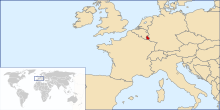Cuisine of Luxembourg
Luxembourg's cuisine reflects the country's position between the Latin and Germanic countries, influenced by the cuisines of neighbouring France, Belgium and Germany. Recently, it has been influenced by the country's many Italian and Portuguese immigrants. As in Germany, most traditional, everyday Luxembourg dishes are of peasant origin, in contrast to the more sophisticated French fare.[1]
Food

Fish from the local rivers such as
Meat dishes include cold
Other dishes include
). French cuisine is featured prominently on many menus, as well as certain dishes from Germany and Belgium.-
Judd mat Gaardebounen served with boiled potatoes and Diekirch beer
-
Bouneschlupp is considered to be a Luxembourgish national dish
-
Träipen, sometimes treipen, is the Luxembourg variant of black pudding
Other notable foods

Other Luxembourg specialties include:
- onions and parsley, then deep-fried.
- Tierteg—Another kind of potato pancake made with sauerkraut.[10]
- Rieslingspaschtéit—A popular loaf-shaped meat pie prepared with Riesling wine and aspic, typically served in slices.[11]
- Pâté—A spreadable paste, usually made of meat though vegetarian versions exist.
- Quetschentaart—A plum tart; it, along with peach, cherry, and pear tarts are a typical dessert and can be found in any pastry shop or restaurant.
- Miel luxembourgeois de marque nationale—A type of honey from Luxembourg that is protected under EU law.[citation needed]
- Öennenzop—Onion soup that is usually served with cheese toast.
Wine and beer

Beer, which is quite a popular drink in Luxembourg, is produced locally at three large breweries as well as in a couple of smaller establishments. Most of the beer brewed in Luxembourg is lager but there are also a number of special beers as well as beers without alcohol and Christmas beer in December.[14][15] The main brands of beer are Bofferding, who also produce Battin; Mousel and Diekirch, who share the same brewery in Diekirch; and Simon. Since the 2000s there has been a resurgence of local microbreweries creating craft beer such as, Beierhaascht, Ourdaller and Grand Brewing.[16]
See also
References
- ^ " Archived 2012-04-05 at the Wayback MachineNational and Regional Food Specialities" Archived 2012-04-05 at the Wayback Machine, Angloinfo Luxembourg. Retrieved 08 June 2016.
- ^ "La boulangerie-pâtisserie", VisitLuxembourg.lu (in French) Retrieved 30 November 2011.
- ^ "Culinary Luxembourg" Archived 2010-12-07 at the Wayback Machine, eu2005.lu. Retrieved 30 November 2011.
- ^ "Luxembourg Recipes" Archived 2006-02-09 at the Wayback Machine, Luxembourg Tourist Office, London. Retrieved 30 November 2011.
- ^ "Éisleker Ham" Archived 2012-05-02 at the Wayback Machine, Mycitycuisine.org. Retrieved 30 November 2011.
- ^ "Judd mat Gaardebounen" Archived 2018-07-28 at the Wayback Machine, Mycitycuisine.org. Retrieved 30 November 2011.
- ^ "Hong am Rèisleck" Archived 2012-05-09 at the Wayback Machine Mycitycuisine.org. Retrieved 30 November 2011.
- ^ http://www.mycitycuisine.org/wiki/Huesenziwwi Archived 2012-05-09 at the Wayback Machine Huesenziwwi Mycitycuisine.org. Retrieved 30 November 2011.
- ^ Lëtzebuerger Grillwurscht" Archived 2012-05-09 at the Wayback Machine, Mycitycuisine.org. Retrieved 30 November 2011
- ^ "Tiirteg ou Galettes de pommes de terre et de choucroute ( luxembourg )", Recettes de France et d'ailleurs. (in French) Retrieved 1 December 2011.
- ^ "Rieslingspaschtéit" Archived 2012-05-09 at the Wayback Machine, Mycitycuisine.org. Retrieved 2 December 2011.
- ^ "Intro", Luxembourg: Vins & Crémants. Retrieved 2 December 2011.
- ^ "Quality" Archived 2012-04-04 at the Wayback Machine, Luxembourg: Vins & Crémants. Retrieved 2 December 2011.
- ^ "Bières", Luxembourg.lu. (in French) Retrieved 2 December 2011.
- ^ "Wine and Beers of Luxembourg" Archived 2012-04-05 at the Wayback Machine, Anglo Info Luxembourg. Retrieved 2 December 2011.
- ^ "Local products - Luxembourg specialities", ONT Luxembourg. Retrieved 9 December 2012.
Further reading
- ISBN 2-87954-052-6
- ISBN 2-9599-85427(in German)
External links
- Luxembourg cuisine from Mycitycuisine.org with links to many traditional recipes.
- Article about Luxembourgish cuisine on the official page of the 2005 Luxembourgish Presidency of the Council of the EU
- Luxembourgish recipes on commerzbank.lu[permanent dead link]
- Luxembourgish recipes on 2travelandeat.com (in French)



